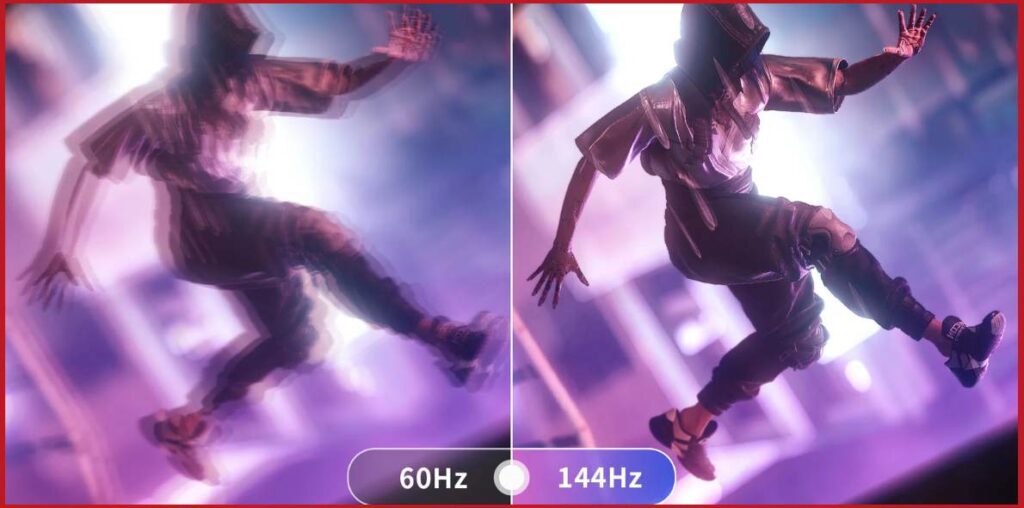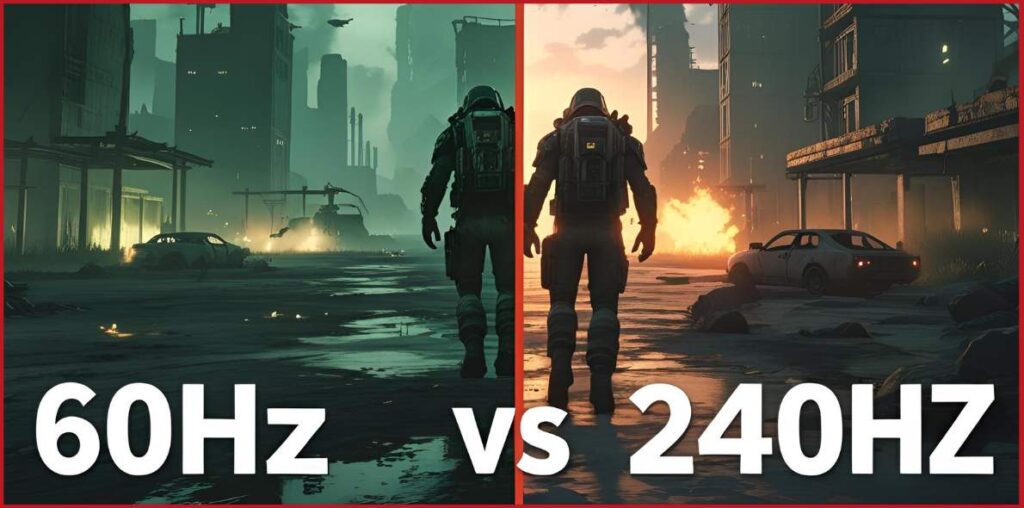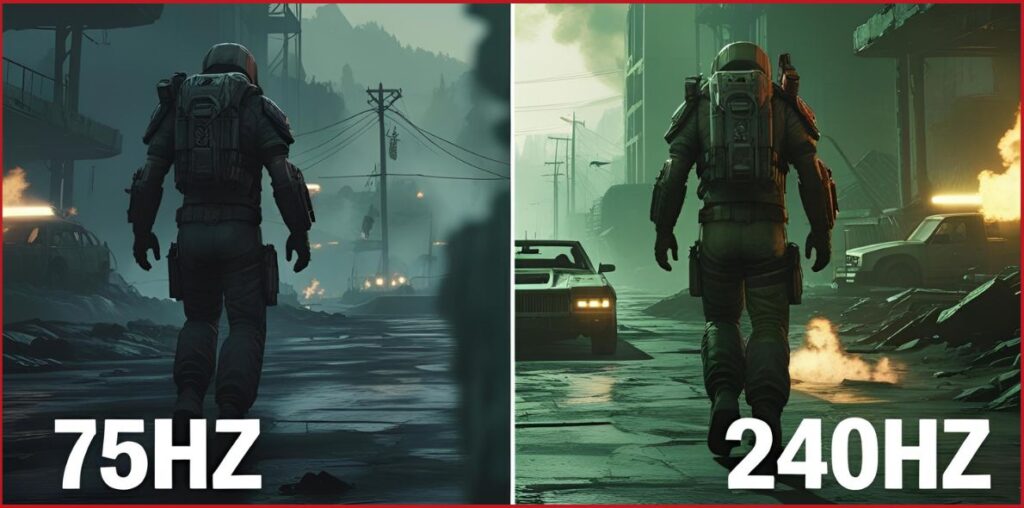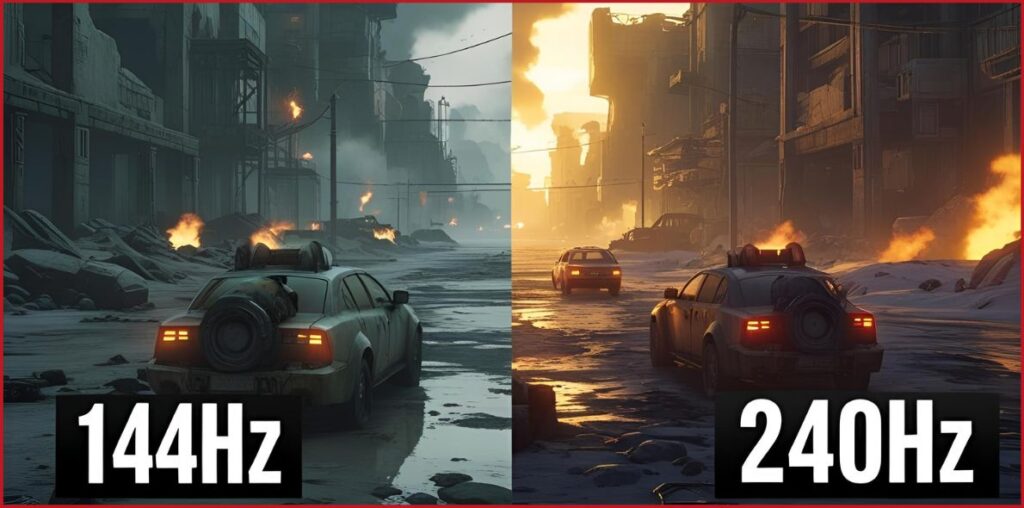REFRESH RATE TEST TOOL
Test your monitor’s refresh rate and display performance with our professional tools
Your Screen’s Refresh Rate
📊 Live FPS Counter
Real-time frame rate monitoring to see how smoothly your display is performing.
🎯 Smooth Motion Test
Watch the red dot move across the screen. Higher refresh rates will show smoother motion.
⚡ Strobe Test
Test for screen flickering and refresh rate consistency.
🌊 Pattern Test
Animated pattern test to check for motion blur and refresh rate performance.
What Is a Refresh Rate Test?
Running a refresh rate test on your monitor is one of the most convenient and simplest ways to verify whether your screen is performing at the expected Hertz (Hz).
From my own experience testing various monitors, I’ve found that even when the settings show the correct rate, it’s still essential to evaluate the screen’s performance through a reliable website that assesses the timing, frequency, and screen rate.
Just take a moment, wait, and let the tool run in your browser—the result often reveals what the raw data and system output might miss.
This kind of real-time analysis gives you an accurate measurement of your display’s speed, highlighting any possible flicker or lag.
It’s not just about high-end graphics or resolution; it’s about ensuring your hardware translates the input into smooth visual transitions at the expected quality level.
Whether you’re adjusting the computer display or double-checking an advertised value, this test helps you determine if everything from frame rendering to screen display is working as it should.
What Is Refresh Rate?
The refresh rate refers to how many times per second your screen or monitor updates the display with new images, measured in Hertz (Hz).
From working with various hardware setups and tweaking graphics for better performance, I’ve learned that this measurement plays a crucial role in the overall visual experience—especially in fast-paced gaming or high-resolution video playback.
A higher refresh rate means smoother motion and less flicker, enhancing the quality of what you see. This rate directly affects the speed at which frames appear, influencing everything from mouse movement to input responsiveness.
Whether you’re configuring a new computer or simply adjusting settings, knowing your monitor’s screen rate ensures you get the best output based on your resolution, frequency, and system capabilities.
Proper evaluation helps determine the correct rate and ensures your display performs with accuracy and consistency across various timing conditions.
How To Check Monitor Refresh Rate?
To check your monitor’s refresh rate, the simplest and most convenient method is to use an online tool that performs a real-time refresh rate test directly in your browser.
From my own setup adjustments, I usually start by going into the display settings on my computer to view the current Hz value, but that doesn’t always reflect the accurate rate at which the screen is updating.
That’s where a good website comes in—it quickly assesses the actual performance by measuring the screen rate, timing, and frequency of frame changes.
You just have to take a second, wait, and let the system evaluate the data for a more reliable result. This analysis ensures that your output matches what your hardware is capable of delivering, maintaining high quality, resolution, and smooth visual transitions.
If you’re serious about ensuring your display behaves correctly, this is the way to determine if the value being shown is actually the correct one.
How Does Refresh Rate Affect Gaming Performance?
From firsthand experience tweaking my computer setup for better gameplay, I’ve noticed that the refresh rate has a huge impact on overall gaming performance.
A higher Hz means the monitor refreshes the screen more frequently, allowing for smoother visual transitions and reducing flicker during intense scenes.
This affects how quickly new frames are displayed, which in turn improves input response, especially in fast-paced or competitive games.
When your hardware and graphics can support higher frequency, and your settings are tuned correctly, everything—from character movement to camera shifts—feels more natural and fluid.
Using a refresh rate test is the simplest way to verify that your display is delivering the performance you expect. These tools run directly in your browser and assess the timing, rate, and output, giving you accurate data in real-time.
It’s this precise evaluation that helps determine whether you’re getting the most out of your system’s resolution, quality, and speed to match your in-game demands.
Better Motion Resolution

A higher refresh rate directly contributes to better motion resolution, which is critical for gaming. From my own use of high-performance monitors, I’ve seen how improved screen clarity during fast motion gives players a noticeable edge.
With enhanced visual clarity, you can react to what’s happening on the display with precision, improving your chances to win.
Unlike low Hz screens that often result in sluggish or flicker-filled motion, high frequency panels allow smoother frame rendering and superior performance, especially in high-speed gameplay.
When paired with the right hardware and graphics settings, you’ll notice an immediate quality improvement in every move you make on-screen.
Eliminate Ghosting and Tearing

Ghosting and tearing are often caused when your monitor struggles to keep up with the output of your video card.
I’ve experienced this while testing different computer displays—especially when the refresh rate wasn’t aligned with the frame rate being pushed by the GPU.
This mismatch can disrupt timing and lead to a jarring, broken visual experience that interferes with gameplay or media.
However, using a refresh rate test to verify and tune your screen rate allows you to evaluate the performance in real-time and determine if your display is refreshing quickly enough.
A high Hz rate resolves these issues by producing accurate frame transitions and smoother motion across the resolution, ensuring immersive and uninterrupted action.
Fast Responsiveness

When it comes to responsiveness, input lag is the deciding factor, and that’s tied directly to how fast your monitor can refresh. A higher refresh rate means your screen can respond faster to your actions, which is vital in competitive gaming.
From tweaking my own setup, I know that even milliseconds count—especially in shooters or racing games. With low lag, each movement, click, or action is reflected instantly on the screen, reducing the delay between the data you send and what you visually perceive.
A quick check using a browser-based tool can give you an accurate picture of your display’s speed, rate, and overall performance. The difference may seem small on paper, but it has a major impact on real-world gameplay.
Different Types Of Refresh Rate
Different types of refresh rates impact how smoothly visuals appear on a screen. From 60Hz to 240Hz and beyond, each level brings a noticeable difference in motion clarity and responsiveness.
Gamers and content creators often prefer higher refresh rates for better performance. Choosing the right one depends on your device, usage, and frame requirements.
60 HZ

Different types of refresh rates impact how smoothly visuals appear on a screen. From 60Hz to 240Hz and beyond, each level brings a noticeable difference in motion clarity and responsiveness.
Gamers and content creators often prefer higher refresh rates for better performance. Choosing the right one depends on your device, usage, and frame requirements.
75 HZ

A 75Hz refresh rate offers a noticeable upgrade over 60Hz, displaying 75 images per second for smoother visuals during everyday tasks and casual gaming.
It strikes a balance between performance and affordability, making it ideal for users wanting better motion clarity without a high-end device. While not built for intense high frame games, it’s well suited for general use.
The improvement in frame requirement handling makes play more fluid, especially in fast-moving scenes.
144Hz

A 144Hz refresh rate delivers 144 images per second, offering a major leap in smoothness compared to 60Hz or 75Hz, especially noticeable in fast-paced games.
It’s highly suited for high-end gaming, where quick reactions and reduced motion blur matter most. This refresh rate handles demanding frame requirements with ease, making play feel more responsive and immersive.
If your device supports it, the upgrade can show a dramatic improvement in both visuals and performance.
240 HZ

With a 240Hz refresh rate, you’re experiencing an ultra-smooth output of 240 images per second, designed specifically for competitive high-end gaming.
It’s ideal for games with intense frame requirements and rapid moving images, where every millisecond counts.
A device that can show this level of performance ensures fluid play and sharper motion clarity, far beyond what 60Hz or 144Hz can offer.
Though not essential for all users, it’s perfectly suited for those who demand precision and speed in every game session.
Why High Refresh Rate Important For Gaming?
A high refresh rate is crucial for gaming because it allows the screen to show more images per second, resulting in smoother motion and faster response times.
For games with a high frame requirement or lots of moving images, this reduces blur and input lag, giving players a competitive edge.
Whether you’re using a device with 144Hz or 240Hz, the difference in gameplay fluidity compared to 60Hz is instantly noticeable.
It makes play feel more natural, sharp, and immersive—especially in high-end gaming where every frame matters.
Why Choose Us?
Choosing us means trusting a team that understands the importance of every refresh rate—from 60Hz to 240Hz—and how it impacts your device performance, especially in gaming.
We focus on delivering tools and insights tailored to handle frame requirements, support high-end gaming, and enhance how visuals show on screen.
Whether you’re aiming for better play quality or smoother moving images, our solutions are suited to help you experience more fluid and responsive games per second.
Conclusion
Choosing the right refresh rate, whether it’s 60Hz, 75Hz, 144Hz, or 240Hz, can transform how you play, view moving images, and meet the frame requirements of modern games.
From casual sessions to high-end gaming, the way your device handles each image per second affects the entire experience.
A higher refresh rate doesn’t just improve visuals—it enhances responsiveness, making every game feel sharper and more immersive. The key is finding the option best suited to your needs and letting your screen truly show its potential.
FAQs
1. What does 60Hz refresh rate mean?
It means your screen can show 60 images per second, which is the lowest standard refresh rate commonly used in many devices today.
2. Is 60Hz good for gaming?
For basic games with minimal frame requirements and fewer moving images, 60Hz is suited, but it’s not ideal for high-end gaming.
3. How does 75Hz compare to 60Hz?
A 75Hz refresh rate offers smoother play by displaying 75 images per second, reducing motion blur over 60Hz in many games.
4. Is 144Hz worth it for gamers?
Yes, 144Hz is highly suited for competitive gaming as it handles high frame requirements and rapid moving images more efficiently than 60Hz or 75Hz.
5. What is the advantage of 240Hz over 144Hz?
With 240Hz, a device renders 240 images per second, which enhances visual clarity and responsiveness for elite-level play in demanding games.
6. Does refresh rate affect gameplay?
Absolutely. Higher refresh rates help reduce screen tearing and input lag, improving overall game responsiveness and visual fluidity.
7. Can my device handle a higher refresh rate?
Your device must meet certain hardware frame requirements to show higher refresh rates like 144Hz or 240Hz effectively.
8. Which refresh rate is best for casual gaming?
For casual users, 75Hz is often well suited—a noticeable step up from 60Hz without needing a high-performance device.
9. Do all games support high refresh rates?
Not all games are optimized for higher frame outputs, so performance can vary depending on the game and system capabilities.
10. Is a higher refresh rate better for eyes?
Yes, higher refresh rates reduce flickering and strain during play or work, especially in fast-motion games or media with heavy moving images.
